A Farewell to Ice
Air Date: Week of October 27, 2017
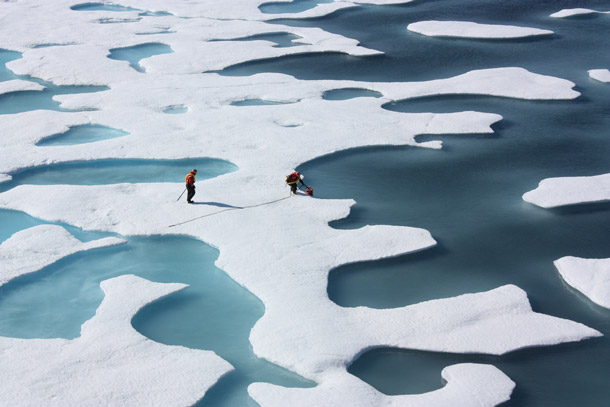
Melt ponds on Arctic sea ice, July 2011. (Photo: NASA Goddard Space Flight Center, Flickr CC BY 2.0)
Year by year, the Arctic sea ice cover is dwindling, driven towards seasonal extinction by global warming. And the vanishing ice is having profound effects on the rest of the world. In A Farewell to Ice: A Report from the Arctic, polar researcher Peter Wadhams describes what’s happening to the thawing world in the North, drawing on his decades of study there. Living on Earth’s Helen Palmer spoke with Wadhams about the crisis facing our planet and what might be done to thwart disaster.
Transcript
CURWOOD: It’s Living on Earth, I’m Steve Curwood. The book’s title says it all – A Farewell to Ice. It’s the result of nearly a half-century of personal ice research, mostly in the Arctic, by Peter Wadhams, he’s head of the Polar Ocean Physics Group at Cambridge University. And the fast retreat of glaciers and polar ice is sobering if not terrifying in what it implies for the future of life here on Earth. Living on Earth’s Helen Palmer met up with Peter Wadhams at the Oxford University Press offices in Manhattan.
PALMER: Peter Wadhams, I have to say your book "A Farewell to Ice" paints a very grim picture. How early were you aware that things were going downhill, as it were?
WADHAMS: Well, it took a long time before we realized things were changing, and I think for me, the realization came when, in 1987, I did a submarine voyage over the same grounds that I'd followed in 1976 and found that the ice was much thinner, it was about 15 percent loss of ice over a huge area of the Arctic, so that was my first realization that the situation was not stable.
PALMER: Now, your book is full of incredible graphs and tables and one that I found particularly telling is what you call the Arctic death spiral. Can you explain that to me and describe it?
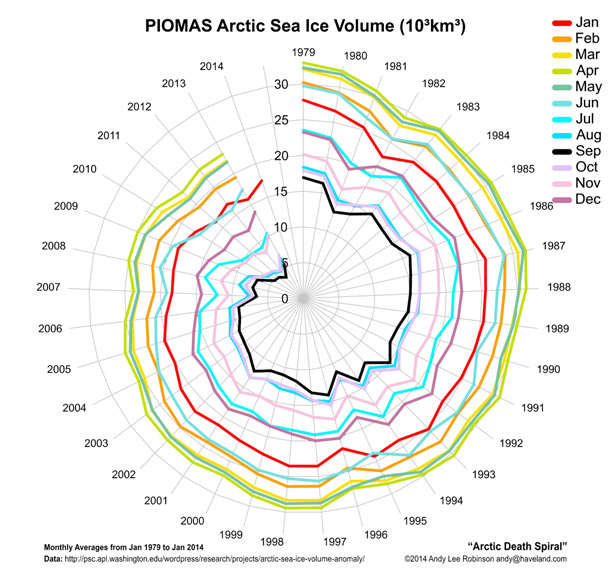
The “Arctic Death Spiral,” which shows how sea ice extent is spiraling through time towards oblivion. (Photo: Andy Lee Robinson, Creative Commons)
WADHAMS: Well, it was not invented by me but a scientist called Mark Serreze at the University of Colorado, and it's a way of representing the decline in the volume of ice in the Arctic on a month-by-month, year-by-year basis. So, what you do is have a clock shaped graph where, going out from the center, you have the volume of ice during each month of each year. So, you start off in the 1970s where the data began, and then you move around the clock clockwise, for each month looking at how the volume changes from year to year, and if there was no change going on, then each of the curves for each month would be a circle. So, you'd have a bunch of concentric circles, but because the ice is thinning and retreating the curves actually draw in towards the center, so it's like a spiral. And September is the month that will reach the center first because that's the month with minimum area of ice, and so it's a death spiral in the sense that first September will reach the center and wipe itself out for ice cover and then a few years later probably be July, August, October, and November while the ice remains in the winter, but its volume still decreases.
PALMER: So, what are the implications of that graph as you see it?
WADHAMS: Well, implications are that the Arctic is changing from being a permanent ice cover to becoming a seasonal one, and that will have big changes on ocean currents to circulation of the atmosphere, fisheries as well, and especially to the air temperature which will warm up because there isn't any ice cooling the surface anymore, and that will have an effect, for instance, on air currents over Greenland which will increase the melt rate of the Greenland ice sheet.
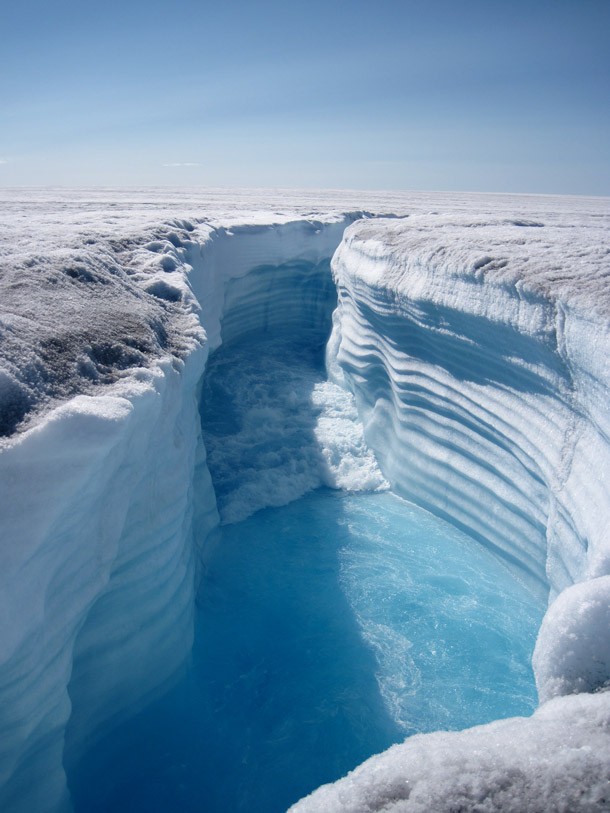
Surface melt water erodes channels into the Greenland ice sheet, eventually reaching the sheet’s bed and making it slip away into the sea faster. (Photo: Henry Patton, Flickr CC BY 2.0)
PALMER: Now, obviously the increase of Carbon Dioxide in the atmosphere, which we are very aware of from about 280 parts per million to over 400, is one of the major causes of the warming we're seeing. What other causes are there of this warming?
WADHAMS: Well, CO2 is probably the main source, but there is also an increased warming due to methane. We're finding increased methane emissions partly from the fact that people are careless with gas pipelines and fracking, and we're getting more methane going into the atmosphere from those sources, and partly it's methane coming from shallow water in the Arctic where underneath the shallow Arctic continental shelves there’s frozen ground, there's permafrost left over from the last ice age, and that permafrost acts as a cap over lots of methane contained in the sediments. That cap is being removed as the permafrost melts and the methane is being released.
PALMER: And of course methane in the short-term is a very powerful greenhouse gas. Are we certain that it is actually escaping? Are we seeing it escaping in the polar oceans?
WADHAMS: Oh, yes we're seeing it escaping every year. There’s a research voyages into the Russian Arctic seas – that's the Siberian Sea and the Kara Sea – and it's just more and more every year. The fear is that all the permafrost will melt in one rapid go, and then the amount of methane that comes out will be a huge pulse, and that would have a detectable climate change, in fact, maybe 0.6 of a degree is something we modeled, very rapidly, so it would be a just a big jerk to the world climate.
PALMER: And of course the idea is to keep the global temperature below two degrees Celsius, and we're already at about 1.2 degrees Celsius of warming. So, 0.6 takes us virtually there.
WADHAMS: Yes, but we're at 1.2 and even without any further carbon dioxide emissions we'll probably rise to two because not all of the intrinsic warming that's given by certain carbon dioxide level actually is realized immediately. It takes years for the effects to come through in the temperature of the oceans, for instance. If we stopped emitting carbon dioxide and just stayed put, the temperature would still rise for a while.
NASA video: Arctic Sea Ice from March to September 2017. (Credit: NASA's Scientific Visualization Studio/Helen-Nicole Kostis)
PALMER: There's another problem with the ice being gone; it does also have a kind of like a feedback effect on heating up the Arctic. Can you explain that?
WADHAMS: Well, yes, in fact the strongest effect on accelerating Arctic warming is the fact that as the ice retreats you're replacing a surface that reflects about 80 percent of the radiation from the sun straight back into space.
PALMER: That's because there's ice and snow and white cover.
WADHAMS: Yes, it is white and solar radiation is in the visible band, and so the fact that is white shows it’s reflecting, and you replace that by dark water or on land by dark tundra and that reflects only 10 percent or less of the energy falling on it, so you're changing from 80 percent reflection to 10 percent reflection and that's a huge extra amount of radiation absorbed by the Earth's surface or the ocean surface, and really increases the way of warming. That's called the albedo feedback.
PALMER: And of course another important factor of the polar ice cap was that it helped to cool the climate generally. It was this great air conditioning sort of system that it created and we're losing that.
WADHAMS: Yes, because it had a lot of effects. The fact that the sea ice was still there in the summer meant that it stabilized the air temperature at being not higher than zero degrees because if the air temperature got warmer it would just melt some of the surface snow and ice and it was an air conditioning system for the air, but it was also an air conditioning system for the ocean, that the ocean couldn't warm beyond zero degrees because otherwise the ocean heat would melt some of the ice from below. So, as long as there was still ice there to be melted, it kept the temperature of the atmosphere and the temperature of the ocean at about zero degrees. So, that prevented warm air from wafting over Greenland, which it’s now free to do, and it prevented warm water from melting the subsea permafrost, which it is now doing. So, it was performing two very useful functions both of which have now stopped.
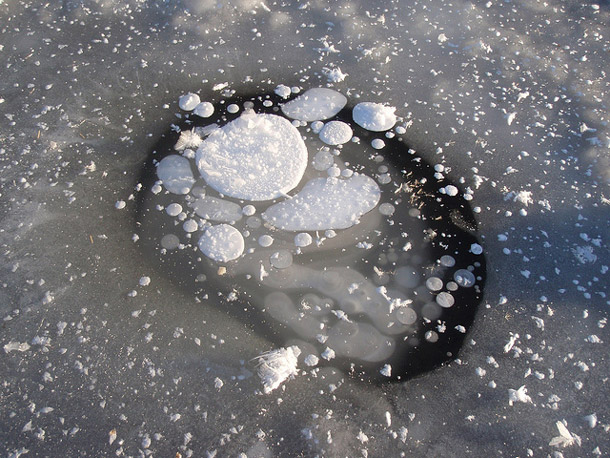
Methane bubbles frozen in lake ice in Alaska. As the Arctic thaws, permafrost on land and continental shelves in shallow waters are releasing methane into the atmosphere at an increasing rate. (Photo: Miriam Jones, USGS Flickr public domain)
PALMER: Several countries do see that there are economic opportunities in the ice-free Arctic, certainly for shipping and fossil fuel developments and new fishing grounds. What is your take on that?
WADHAMS: Well, we did an analysis of the costs of global warming. This was based on the model used by the Stern Review which was the review for the UK government on climate change costs, and even a methane release, which is a burst of methane giving a 0.6 degree warming, would be the equivalent (in terms of economic cost) of about 60 trillion dollars which is a fraction of what the total cost of global warming, really, but It's the cost of that amount of warming. Now if we're talking about trillions of dollars of cost to the world for global warming, then the billions of dollars which you can make out of increased shipping across the Arctic or increased rate of oil drilling becomes trivial.
PALMER: Now, early in your career you did some absolute fascinating research on the effects of oil in the Arctic, and obviously one of the plans of certainly the Soviets and indeed the current government in the US is to increase drilling in the Arctic. What did you find about the effects of oil when it's spilled in Arctic waters?
WADHAMS: Well, the effects of an oil spill are pretty frightening. When I was working on it full time, when I was in Canada you were allowed to do oil spills in the open sea to study what the effects were and we – we did an oil spill all through winter in a bay in the Canadian Arctic and then spilled some more oil under ice, and what we find is that oil when it's spilled under ice through a blowout on the seabed, the oil collects under the ice and then gets incorporated in the ice by new ice growing underneath the oil, so you have what's called an oil sandwich, and the ice drifts away because the ice is moving, and over winter you can have a huge area of the Arctic covered with ice floes which contain oil sandwiches. You can't detect the oil because it's incorporated in the ice, but as soon as summer comes along and the ice floes melt, the oil starts to come out and you find a vast area of the Arctic with little pockets of oil coming out from the melting ice which is virtually impossible to clean up.
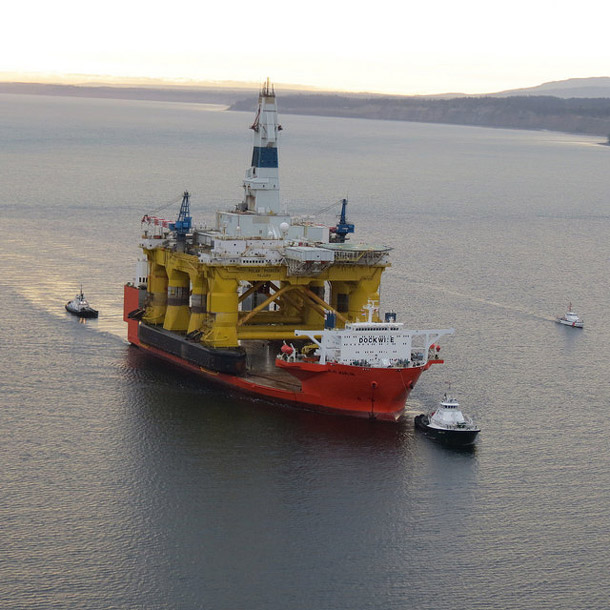
An oil spill in the Arctic would be far more difficult to clean up than elsewhere, says Peter Wadhams. The Royal Dutch Shell Oil drilling rig Polar Pioneer is shown above. As of September 2015 Shell has suspended its Arctic offshore drilling program. (Photo: Air Station Port Angeles / U.S. Coast Guard, Flickr CC BY-NC-ND 2.0)
It will be far more expensive than the Gulf of Mexico spill, for instance, and I think it's had an effect; when we wrote the report and published it, Shell was busy exploring in the Chukchi Sea and that year they just gave up. They said it was because there wasn't any oil, wasn’t any good oil. But we suspect it was because it would be expected that if there were not a big blowout the company that did it would have to foot the bill with the way that BP did with the Deepwater Horizon, so, they decided probably it was more fruitful to go do some fracking instead.
PALMER: So, obviously you're painting a pretty sort of dire picture for us of where we're going with the ice. So, you do propose something like a geoengineering approach at least for the short term. I mean isn't that sort of like a counsel of despair really?
WADHAMS: Yes, it's a counsel of despair in a way and also there's a very legitimate criticism that if you do something that gets rid of global warming or hides global warming, then it enables everybody to carry on with their nasty habits and not reform and be more virtuous, and that's absolutely true, but the trouble is it's very hard to make the human race reform and be virtuous. They would far rather carry on living the way they're used to living, and the feeling which I suppose is the tragedy of the commons is why should I give up my SUV just because it emits a lot of CO2 when it's only going to have a tiny effect on global warming? So, we have to go to the technological solutions because we can't depend on people's virtues for the solution of abstaining from emitting carbon dioxide.
PALMER: So, there are several potential solutions. Tell me about the one that you think has the most valiancy.
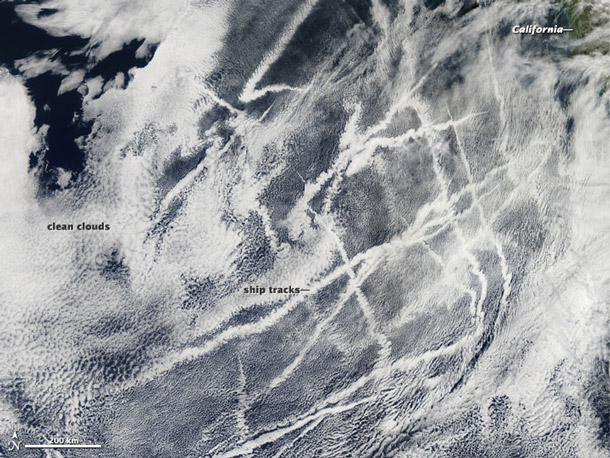
Above, a satellite image shows “ship tracks” across the Pacific Ocean, which form when water vapor condenses around tiny particles of pollution that cargo ships emit. This is the phenomenon that marine cloud brightening would seek to take advantage of to cool the Earth. (Photo: Jeff Schmaltz, LANCE/EOSDIS MODIS Rapid Response Team at NASA GSFC, Flickr CC BY 2.0)
WADHAMS: Well, there's two that I think would work. The first one is to hold back global warming although it doesn't affect carbon dioxide levels and it doesn't affect what that's doing to the oceans, but to hold it back is a method called marine cloud brightening where you have a drone ship drifting around with very tall masts which inject a carefully calculated size of tiny sea water droplets into the bottoms of clouds and that brightens the cloud up because of the small size of these particles and increases albedo which could hold back global warming, and the advantage of that is that the effects stops as soon as you stop applying it. So, if there's some accidental bad effect on some part of the world, you can simply stop. Whereas other methods like releasing aerosols into the stratosphere, you can't do anything, you have to wait until it falls out of the stratosphere, but it's still not a solution. It's a sticking plaster. A real solution is taking carbon dioxide out of the atmosphere, and I think we have to do that if we're going to save the world in the long term.
PALMER: Professor Wadhams, is it possible that your conclusions are too pessimistic?
WADHAMS: Well, actually I'd like to think of mine as optimistic because a lot of people who analyze the situation of the planet and write polemical accounts are so despairing that they end up saying, “We're doomed so we should all go and live on mountain tops with guns and so on.” I think that's bad because we do have ways to save ourselves and I think geoengineering is a way to stop the warming getting to the point where it's very very seriously affecting our society, and CO2 removal is something that I think will work because it does work already, but it just costs too much but it will be made to be cheaper and when it's made to be cheaper it can save us so I think we can save ourselves.
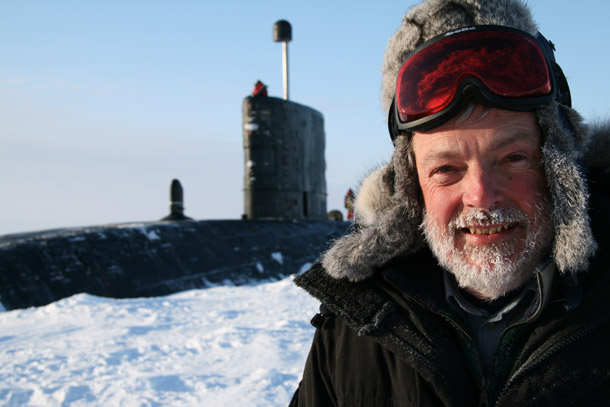
Peter Wadhams is the author of A Farewell to Ice and Professor of Ocean Physics at Cambridge University, where he directed the Scott Polar Research Institute from 1987 to 1992. (Photo: courtesy of Peter Wadhams)
And the optimistic thing is we can save ourselves without becoming more virtuous because if we can find a way to get rid of CO2 in the atmosphere, then people who want to drive Ferraris around and SUV and so on can keep on doing so up to a point. You know, you're not going to forcibly abolish fossil fuels, so we don't have to become suddenly virtuous people. We can combine it with still keeping some of our old habits which means it's more likely to happen.
CURWOOD: Cambridge University professor Peter Wadhams book, A Farewell to Ice, is based on nearly 50 years of research in polar waters. He spoke with Living on Earth’s Helen Palmer.
Links
Living on Earth wants to hear from you!
Living on Earth
62 Calef Highway, Suite 212
Lee, NH 03861
Telephone: 617-287-4121
E-mail: comments@loe.org
Newsletter [Click here]
Donate to Living on Earth!
Living on Earth is an independent media program and relies entirely on contributions from listeners and institutions supporting public service. Please donate now to preserve an independent environmental voice.
NewsletterLiving on Earth offers a weekly delivery of the show's rundown to your mailbox. Sign up for our newsletter today!
 Sailors For The Sea: Be the change you want to sea.
Sailors For The Sea: Be the change you want to sea.
 The Grantham Foundation for the Protection of the Environment: Committed to protecting and improving the health of the global environment.
The Grantham Foundation for the Protection of the Environment: Committed to protecting and improving the health of the global environment.
 Contribute to Living on Earth and receive, as our gift to you, an archival print of one of Mark Seth Lender's extraordinary wildlife photographs. Follow the link to see Mark's current collection of photographs.
Contribute to Living on Earth and receive, as our gift to you, an archival print of one of Mark Seth Lender's extraordinary wildlife photographs. Follow the link to see Mark's current collection of photographs.
 Buy a signed copy of Mark Seth Lender's book Smeagull the Seagull & support Living on Earth
Buy a signed copy of Mark Seth Lender's book Smeagull the Seagull & support Living on Earth

